The challenge which climate change poses for the coast
The evidence of the impact of climate change on both human activities and ecosystems is stark. It represents a challenging task to our society, which has become aware of the planet on which it lives and the delicate equilibrium that safeguards its present and future living conditions. The coast is the first line of defence against the effects of climate change on the oceans and is, perhaps for that very reason, all the more vulnerable to its pernicious effects. It thus transpires that on the coast we encounter an interesting store of proof of how society can implement adaptation measures satisfactorily.
As is already widely accepted and demonstrated by highly reliable studies, the global mean sea level (GMSL) is not only rising, but doing so at an increasingly brisk pace. The accelerated rate is significant, since it compromises our response capability by shortening the time available for developing adaptation measures. Moreover, apart from this set of problems, there is evidence of an increase in extreme phenomena along the coast. These coastal phenomena are associated with meteorological tide levels and storm surges, and can be categorised within the general concept of extreme sea levels (ESLs).
Such exposure of the coastline to the effects of the rise in the GMSL and ESLs is even greater on account of determinants that are not wholly climate-related, such as the trend toward human overpopulation on the coast or anthropogenic land subsidence
(1). It is precisely this non climate-related component which makes local dependence very strong and means that adaptation studies have to be
ad hoc and individualised down to physiographic unit scale.
Coastal ecosystems are characterised by presenting a certain degree of difficulty when it comes to discerning the origin of impacts. In general they will be affected by a blend of factors that relate to both the increase in indicators of mean sea level (MSL) and ESLs, and the set of socio-economic activities that take place offshore and onshore. Even in zones relatively far-removed from the coast, anthropogenic action can impact on the system. As a clear sign of this, for example, we could mention sediment management in hydrographic basins.
We should not lose sight of the fact that human activities on the coast can exacerbate its exposure and vulnerability, with the result that, given a rise in MSLs and ESLs, there is a higher risk of adverse effects from coastal floods. In fact, in the present context it is hard to distinguish whether the exposure of a zone to coastal flooding is attributable to climate factors or direct man-induced causes, which amounts to a complex, though necessary challenge to tackle with the goal of proposing and implementing effective adaptation measures.
Another aspect to bear in mind is that along certain sections the coastline is already under a great deal of pressure and highly confined, which means that it is likely to have lost its ability to adapt to climate change naturally via demographic processes, such as progressive migration inland, to offer one example. It should also be stressed that the ecosystems on the coastline play a very important role as natural shields against coastal storms.
Lastly, another feature typical of the coast is its high dependence on the local factor, which can give rise to substantial variations relative to global estimates of the various different oceanographic variables of interest. This is likely to be the case of the local subsidence in many deltas caused by human activity for example, which ought to be taken into account to be in any position to make proper projections of the rise in the MSL in the zone and thus obtain adequate scenarios for suitable projection of adaptation measures.
Coastal management in reply to climate change
Responses to the impact of climate change in the form of adaptation are highly diverse across the world, although they have generally been implemented in reaction to present risks or natural disasters. We should remember that we need a long-term outlook in risk management as regards the coast to optimise resources in developing adaptation measures.
In the long term, the climate values that are chosen to define what action needs to be taken to reduce the vulnerability of the Spanish coast rely very heavily on the climate scenario considered. In addressing this issue, the United Nations Intergovernmental Panel on Climate Change (IPCC) looks at four scenarios (Representative Concentration Pathways or RCPs) which serve as a basis for determining the strategies that correspond with different measurements of radiative forcing
(2) in relation to greenhouse gas (GHG) concentration levels (Figure 1).

Figure 1. Emission scenarios according to the IPCC.
There are also nationally-promoted developments to build the long-term view into management of the coast. Suffice it to mention the recent work by the Directorate General for the Coast and Sea on updating the databases for climate change projection on the Spanish coastline or for climate change adaptation strategies for Spain’s coast.
The project titled “Designing the methodology and databases for projection of the impacts of climate change on the Spanish coast” develops regional climate change projections for marine variables that are needed for monitoring and assessing impacts on the coastal and marine zone. To summarise, to develop this new database seven global models were used, which were subjected to dynamic downscaling (3) to reach local scales, with climate bias correction made for them one by one, thus enabling variables to be obtained for swell, meteorological tide set-up, sea-level rise and surface temperature for two RCP climate scenarios, where one relates to emission stabilisation (RCP 4.5) and the other one would imply a high emission level (RCP 8.5).
Nor should we overlook the new developments in remote sensing for coastal monitoring, which are certain to revolutionise our knowledge of the state of the coastal strip and how it evolves. From these we will be able to obtain morphological variables on the coast with a very high temporal frequency compared to the data collection which we used to be able to achieve using traditional methods. In this area the EU’s Copernicus programme will play a key role in promoting products that are useful for managing the coast via its various different services.
Adaptation measures
Having incorporated long-term analysis of climate change effects into coastal management (when our scope for taking action with respect to them is likely to be only limited within a globalised context), we should undertake the adaptation measures required to reduce the risk of climate change effects on the coast. Here, according to the IPCC adaptation measures can be classified into: (a) no response, (b) advance, (c) protection, (d) retreat, (e) accommodation and (f) ecosystem-based adaptation, Figure 2.
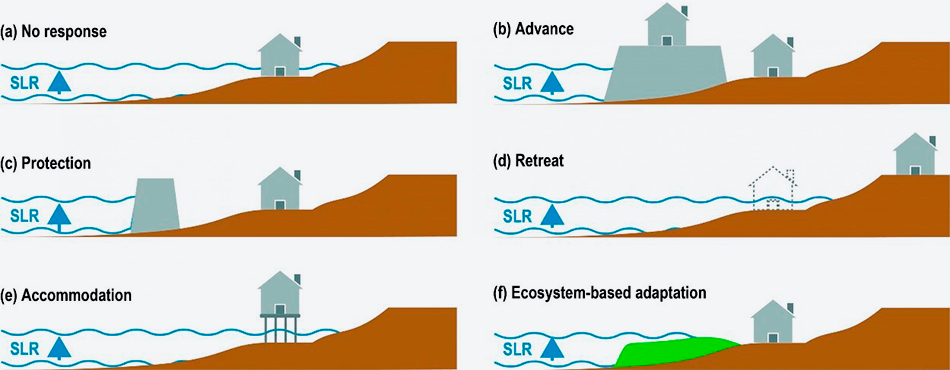
Figure 2. Adaptation measures.
Source: Special Report on the Ocean and Cryosphere in a Changing Climate. IPCC.
All of these adaptation measures to respond to the rise in the MSL and ESLs have synergies and allow a range of actions for sequential and integrated adaptation to climate change on the coast. The IPCC actually recommends hybrid solutions for adapting the coast to climate change so that it is possible to carry out sequential and integrated planning.
Both protection and advance are economically efficient, mainly in established urban zones, although they should often be accompanied by other measures that are aimed at cutting down the increase in exposure in the very long term and which, generally speaking, relate to territorial planning, safety and environmental protection.
When there is enough space to implement them properly, i.e. on non-constrained coasts, ecosystem-based adaptation measures can be effective. These measures also have additional advantages associated with carbon sequestration or improved water quality. Furthermore we should not lose sight of the fact that certain coastal ecosystems can, under certain conditions, migrate landwards, which helps bring about natural adaptation of them to sea-level rises.
On the other hand, accommodation measures are very inexpensive and effective. In fact it could be said that in most cases it is more economical to invest in measures of this type than to opt for no response. Nevertheless, it is a good idea to be aware too that such solutions do not act on protection elements, which means that they lose their effectiveness over time.
Retreat is a measure with a high social impact that, in principle, could only be entertained when the risks of destruction are very high and in zones where no high population density exists. As for advance, this measure is especially advocated when there is no space going inland and big benefits can be obtained in seaward implementation, although this also means an increase in exposure to the effects of a rise in the MSL and ESLs.
In the case of opting for no response, coastal flood damage in the environment can be expected of between two to three times more than current levels by the year 2100 owing to the increase in the strength and frequency of ESLs, according to the latest IPCC report. This option must always be considered, given that it allows us to assess the study of alternatives financially, as the benefit gained can be quantitatively estimated if there is investment in adaptation measures. In Figure 3, we can note the increase in damage in Spain’s coastal zones according to seafront in the case of no response.
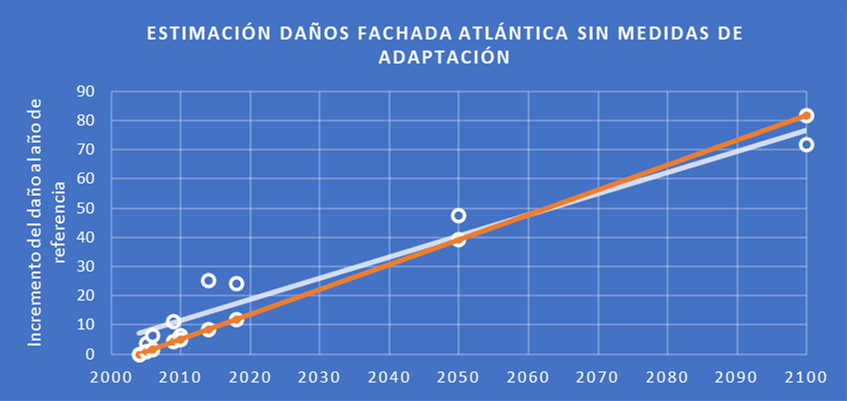
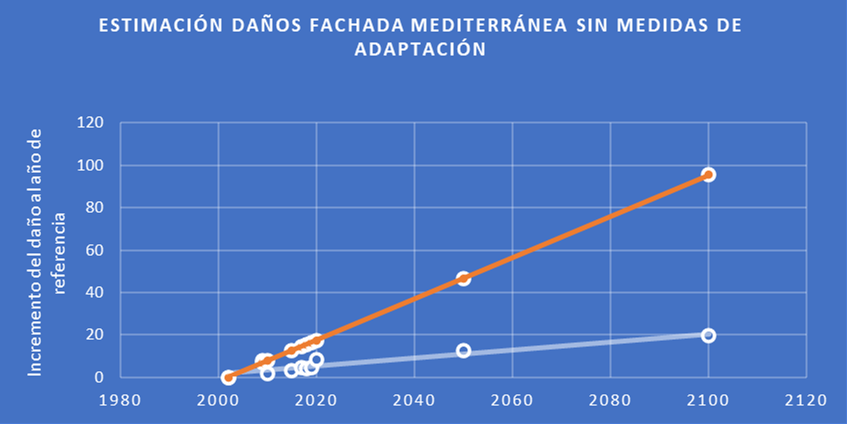
Figure 3. Loss estimations in the Spanish Atlantic Coast (up) and in the Spanish Mediterranean Coast (down) as % increase with respect to the reference year (ca. 2000). Blue line: trend according to the IPCC report; orange line: trend according to data on storm damage. The study has a purely qualitative value. The model has assumed that there is temporal independence between statistical values and that the sample is homogeneous on all seafronts. It does not take into account bias that relates to decision-making, such as adaptation measures.
Advance measures basically consist of reclaiming land from the sea by creating new land beyond the coastline. This measure is considered in some countries as an adaptation measure and is therefore included in the IPCC classification. It generally means that there is no other possible alternative for avoiding serious socio-economic harm. It is particularly taken into consideration in densely populated zones where there is no setting-back option since these are hemmed in on the coastal fringe. An example of this kind of action is the Dutch polder.
Protection measures consist of developing structures that reduce exposure to flooding and lessen the frequency of adverse impacts associated with ESL return periods and the rise in the MSL. Within this category there is a wide range of possibilities, so the right solution will depend on a multi-disciplinary analysis that includes morpho-dynamic, construction-related, functional, administrative or environmental determinants.
If coastal protection is properly designed, it is very efficient in reducing damage associated with ESLs and so, even if it should prove necessary to make something of an investment in them, this effort is more than repaid by the lower expense on repairs or environmental restoration.
Designing coastal protection is complex because other factors can become mixed in with flood problems on coastal zones that have nothing to do with climate change per se. A clear risk linked to this fact is that of designing adaptation measures and plans aimed at resolving the current erosion problem but which fail to take into account future sets of climate change problems.
Besides other climate factors, a significant consequence of the fact that the GMSL is rising and that this is accelerating is that ESLs, which had thus far been exceptional according to available historical data and had return periods of the order of 100 years, will become frequent by the year 2100. Moreover, this is true for all of the RCPs which the IPCC considers and is very dependable. In terms of coastal protection design, this means that storms on the coast with a return period within the acceptable safety limits of any design could suddenly fall outside these parameters on being impacted by ESLs with unaccustomed frequency.
We could deduce if this is in fact happening using certain indicators. The increase in ESL frequency should be reflected in an increase in expenditure on coastal restoration. In this respect, even though a larger sample is required and there are significant determining factors, it is actually being observed that the impact of storms on the coast is increasing on every seafront on the Spanish coastline (Figure 3).
This shift in the time series for ESLs, which influences the determination of extreme regimes and, therefore, establishes design variables associated with return periods, must be taken into account when designing coastal protection. Ignoring this fact would mean making investments that do not adequately address coastal zone exposure to climate change effects and which therefore do not represent genuine adaptation measures.
Within the scope of protection measures, we have two clear options: coastal structures and artificial sediment supply. These two measures can be combined with each other in certain cases.
Coastal structures normally consist of dykes or seawalls that provide stability for a physiographic unit that is not in equilibrium, thereby reducing erosion of it and thus allowing greater defence against floods.
Normally, on the coast, unlike with harbours, there are generally no vertical dykes, except in the case of waterfront promenades, so we usually come across solutions of the sloping-dyke kind. This solution enables stabilisation of the sediment dynamics in a zone in disequilibrium. Changes in ESLs can cause hitherto stable systems to lose equilibrium, which is conducive to sloped dykes being used, especially in populated zones where other measures are not efficient. It should also be borne in mind that on coasts in a current state of disequilibrium on account of anthropogenic effects, changes in ESLs can exacerbate such problems and thus speed up its disintegration.
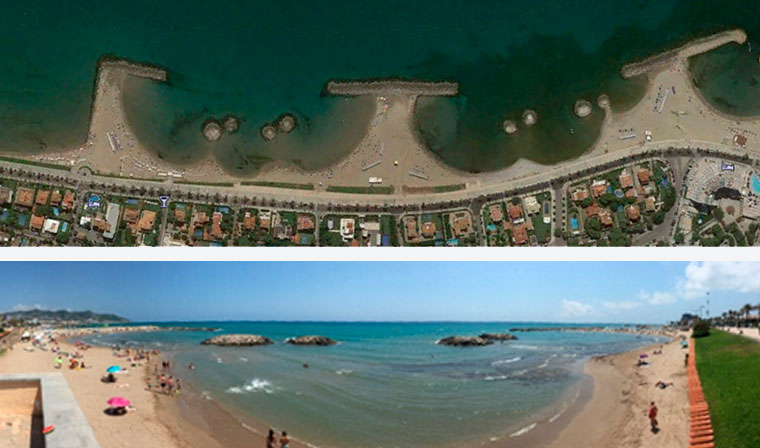
Figure 4. Beach stabilised using a system of dykes and seawalls. Sitges (Barcelona).
The other alternative would be artificial replenishment of sediment systems. In this case a careful analysis of the current and future sediment dynamics is required to determine whether the filling will be stable and if regular replenishment is needed. A key determining factor in this solution is whether it is necessary to perform regular replenishment, which generally tends to be common on the Mediterranean seafront. To be able to perform regular replenishment effectively, it is necessary to be sure of being able to carry this out at the right time, although this is sometimes not possible due to the fact that successive environmental assessments have to be overcome, which delay action, or financing has to be available, which makes it hard to press ahead in a context of annual budgets and restricted multi-year funding allocation.
A good example of how to proceed with this type of solution can be found in Holland in the case of the sand engine (De Zandmotor), which is a replenishment solution that is applied along the southwest coast of the Netherlands. (Figure 5).
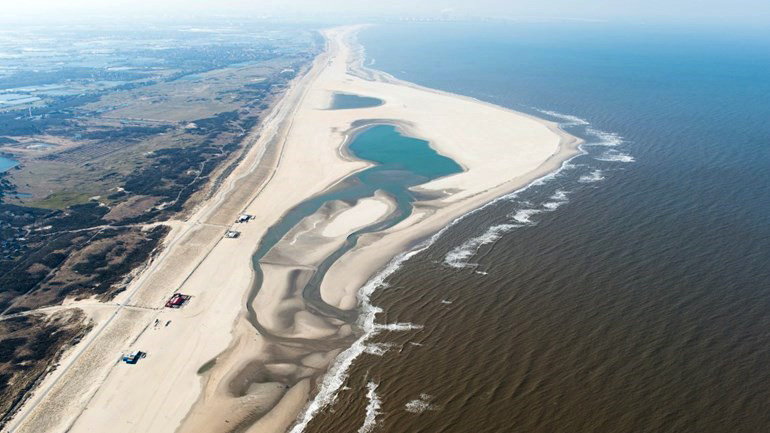
Figure 5. De Zandmotor. Netherlands.
Source: Dutch Directorate-General for Public Works and Water Management (Rijkswaterstaat).
The Dutch sand engine is a fine example of “building with nature”. Taking advantage of the courses predominantly taken by sediment, the sand (which was obtained from sea-dredging) is gradually spread along the Dutch coastline. This has a useful life of 20 years and is intended to combat the erosion of this zone on the Dutch coast by the ESLs caused by climate change.
Retreat reduces a population’s exposure to storms but entails a large social impact from having to move not only the infrastructure, but also the population. This is nevertheless not a novel solution, given that this type of action has already been taken in other fields, such as in building dams and reservoirs to achieve hydraulic regulation.
This option could be considered in zones where the population and its density are low and the risks of coastal damage are very high. On the other hand, it does not appear to be a feasible solution in densely populated zones, where it is better to plump for other alternatives. Whatever the case, owing to its high impact, this option is not usually taken into consideration.
Even so, it should be pointed out that, in terms of Spain, Law 2/2013 on protection and sustainable use of the coastline did in a way examine this option by bringing into Law 22/1998 on Coasts the declaration of land at serious risk of retreat where it is not possible to restore it to its previous state by means of natural processes. The range of options for such land declared at serious risk includes the termination of title for those government concessions that the sea reaches, which would in effect mean the retreat of occupation of this type in coastal zones, albeit on a merely occasional basis.
The accommodation option basically consists of assuming that flooding is unavoidable and that we just have to live with it. This option embraces several alternatives for action, such as, for example: raising buildings, changes in farming culture, using crops that are adapted to a saline environment, or early warning systems. It has to be said that this option includes actions that fall within what are known as resilience measures.
In the context of this type of resilience measure aspects would become involved such as developing evacuation protocols and systems to alert the population, managing land uses, social education and building resilient infrastructure and buildings.

Figure 6. Example of resilience measures in buildings: Watertight modular closing doors in enclosing walls.
Source: Guide to reducing the vulnerability of buildings to flooding. (CCS, 2017).
Resilience measures do not act on existing protection elements, meaning that as they deteriorate, their efficiency will decrease. Mention should also be made of the fact that resilience measures can be combined with other adaptation alternatives to decrease exposure to ESLs.
Finally, we come to ecosystem-based adaptation measures. It should be clarified that although certain protection measures can be thought of as ecosystem-based adaptation measures, they have traditionally been considered as coastal protection measures. This is the case for beach replenishment, which are an example of “building with nature”, as we have mentioned earlier.
The general concept of ecosystem-based adaptation measures is predicated on restoring coastal eco-systems so that, other than having an environmental role, they perform a structural function as coastal flood protection elements. Another example of this kind of action is dune regeneration, where dunes act as a natural beach defence and can both nourish the system with sand when it is eroded and migrate inland when there are rises in the sea level.

Figure 7: Maspalomas dune system. Gran Canaria.
For an ecosystem-based adaptation measure to be successful there has to be enough space and a certain distancing from polluting activities or sources that might have an impact on the system and both threaten its efficacy and prevent it from operating as it should. For example, on busy beaches, marking out paths to reach the sea and restricting access to dunes in the zone where dune regeneration is intended is really decisive, given the fragility of the eco-system in relation to people passing through.
Certain coastal eco-systems, such as mangrove swamps and marshes can relocate inland naturally in response to rises in the MSL. Even so, to do this, there has to be enough space and the rise in the sea level needs to be gradual, which means that any acceleration in the rising process will compromise this ability. Whatever the case, such steady migration helps these natural barriers to be potentially highly effective against climate change, provided that the conditions referred to are in place.
Another aspect to take into account in the response by coastal ecosystems to climate change would be the biophysical variables that can affect them and make them more vulnerable to changes in the MSL and ESLs. Thus there should not be any possible sources of pollution in the zone to be regenerated that arise, for example, from spills or waste that alter concentrations of nutrients and produce eutrophication in the system that can upset its equilibrium. Moreover, the biophysical values associated with an ecosystem can in turn be affected by climate change and such potential variation must be borne in mind to allow proper analysis of how effective it is as a coastal adaptation measure.
Barriers to adaptation
Even if all the information is available and the impact of climate change is certain and the technology is on hand to implement measures and solutions, a wide variety of barriers to adaptation exists. These barriers encompass any kind of challenge or restriction that delays or interrupts adaptation measures. To overcome them, they first have to be identified and then sufficient effort must be spent on surmounting them. To put this into better perspective, it has to be understood that these barriers can range from irrational human behaviour to a lack of funding from the government bodies responsible.
Indeed, the government bodies charged with tackling the effects of climate change often face financial, technical and personnel limitations on adequate implementation of plans, programmes and projects in such a complex context as climate change. On the other hand, the existing decision-making culture within organisations can represent another major hindrance, such as when adaptation to climate change is approached as a purely environmental matter rather than a cross-cutting issue that in reality affects all areas of society. Legislation in itself can also be a barrier to adaptation and, among other things, can stop measures being taken due to the consequences of liability that might arise.
These are just some of the barriers of this kind, but, as has already been said, the spectrum can be a very broad one. As regards this issue, certain specific barriers can be identified on the coast that relate to legislation or adaptation measures. We now go on to outline two examples of these that originate from Spanish experience.
At EU level, the legislation that concerns coastal zones is mainly allocated between two major directives: the Water Framework Directive and the Marine Strategy Framework Directive (MSFD), since both include “coastal waters” within their scope. It is nonetheless necessary to point out that this is not the case at the Spanish level, where we have pioneering legislation on coasts as regards protecting them in the form of Law 22/1988.
Returning to the EU sphere, although it might seem that the coastal zone is covered by these two major directives and therefore benefits from the various initiatives promoted by the EU, the reality is otherwise. This is chiefly because the people who are at the helm of these initiatives are generally more closely linked to the realms of rivers or the sea, which are the dominant subjects in each of the directives, and both unwittingly and tacitly overlook those in charge of coastal affairs.
This implies additional coordination efforts for the European Union and the Member States, which means, in a situation where resources are limited, that the needs of the coastal zone are often not fully met and that the initiatives only adopted from the point of view of the rivers or the sea, with the coast relegated to supplementary status rather than being a core area in its own right. On this point, the general opinion of those in charge of the coasts is that Europe should move in the direction of specific legislation for the coast that features explicit services and lines of action.
Regarding adaptation measures, there is a barrier to implementing those that are aimed at protection, specifically in the area of beach replenishment. We must not forget that beach replenishment serves to solve a problem of disequilibrium brought about by the impact of various human actions, so it should be useful as a corrective measure where impacts of this kind are concerned. On top of this, climate change may exacerbate erosion of this kind and speed up the degradation of the coastal system.
In the case of hemmed in coasts, the most efficient option is protection and, moreover, when it is a viable option for solving the problem, replenishment has the added value of being “building with nature”. Nonetheless, implementing this is running into certain difficulties associated with obtaining material for filling by means of marine dredging. Even though there have been satisfactory experiences involving land matter in replenishing beaches (mainly in the Canary Islands), this type of material is not viable on other Spanish coasts on account of the properties of the indigenous matter, which effectively makes dredged filling material the only option.
In this respect, there is currently no smooth mechanism for obtaining the necessary permits to use sea dredging and implementing the actions afterwards. We should remember that coastal ecosystems are delicate and that erosion or destruction of them affects precisely those species for which protection is sought. There is no doubt that impact analysis must view ecosystems through a broad lens and incorporate a long-term approach that enables a proper equilibrium between protection and adaptation. This means that protection measures must be taken, but the cost of these should always be assessed in terms of any increase in the vulnerability of the coastal system so that we can gauge whether the impact of timely action is compensated by the benefits gained in the long term as opposed to the alternative of no response.
The challenges we face with climate change are considerable, so implementing adaptation measures is complex. Yet, most of society has become aware of this challenge, which has fortunately helped to provide us with more guarantees than ever to surmount this. For some time now we have had a better knowledge of the effects and impact of climate change on the coast, as well as the technology required to adapt. Overcoming barriers to adaptation will only be a matter of political will and social effort, which will set us on the right path to protecting and conserving our valuable coast to the extent that this is possible.





